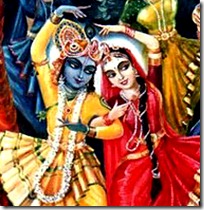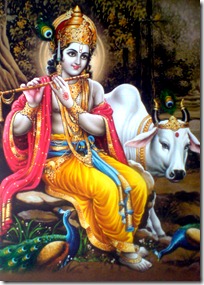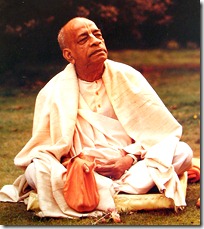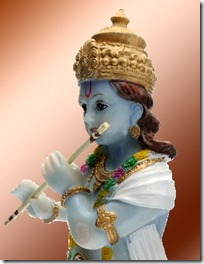 “When a devotee with all his heart and soul serves Krishna, dresses Him in nice garments and gives Him a flower, Krishna smiles. If you can get Krishna to smile upon you just once, your life's goal is fulfilled.” (Shrila Prabhupada, Teachings of Lord Kapila, Ch 7) “When a devotee with all his heart and soul serves Krishna, dresses Him in nice garments and gives Him a flower, Krishna smiles. If you can get Krishna to smile upon you just once, your life's goal is fulfilled.” (Shrila Prabhupada, Teachings of Lord Kapila, Ch 7)Shyamasundara, the original and ever existing form of the Personality of Godhead, has an inexhaustible reservoir of sweetness just ready to flow onto whoever is sincere enough to look at His wonderful face and body. The jivas, the conditioned living entities that are technically part of the marginal energy emanating from the Supreme Spirit, have exercised their freedom by turning their faces away from God. As nothing can be separated from the origin of everything, the material nature and all its miserable components are certainly non-different from the Supreme Lord, but since they are not part of His personal, internal energy, their association cannot bring anywhere near the level of satisfaction to the heart so desperately looking for eternal pleasure that one simple and sincere glance at the smiling face of the Personality of Godhead can. From the wonderful prescriptions provided by the sweetheart of a devotee and saint, His Divine Grace A.C. Bhaktivedanta Swami Prabhupada, we find an easy way to bring to our vision that enchanting smile, an image which subsequently paints a mental picture that won’t go away anytime soon. Indeed, Krishna’s smile is so beautiful that it will kill the pride of even the staunchest of atheists.
 Does Krishna exist? Aren’t the stories found in sacred texts like the Ramayana and Shrimad Bhagavatam just mythological? After all, what rational human being would ever believe in flying monkeys, children lifting gigantic hills, or planets managed by people? Surely these were all concoctions borne of ignorance, the mental speculations of those who didn’t have the advanced knowledge of material science available today. But if such a conclusion were to be followed, then the entire breadth and scope of Vedic literature would have to be discounted. This includes the very existence of Krishna and all the references to geographical locations that are known to exist in real life. In addition, the very tangible information pertaining to medical science and the movements and distances of the different stars in the sky would also have to be ignored. The famous teachings of the Bhagavad-gita, where knowledge pertaining to material nature, the properties of spirit, the reason for the continuation of conditioned life, and the way to get out of the clutches of illusion are very concisely and fully presented, would also have to be discarded. Does Krishna exist? Aren’t the stories found in sacred texts like the Ramayana and Shrimad Bhagavatam just mythological? After all, what rational human being would ever believe in flying monkeys, children lifting gigantic hills, or planets managed by people? Surely these were all concoctions borne of ignorance, the mental speculations of those who didn’t have the advanced knowledge of material science available today. But if such a conclusion were to be followed, then the entire breadth and scope of Vedic literature would have to be discounted. This includes the very existence of Krishna and all the references to geographical locations that are known to exist in real life. In addition, the very tangible information pertaining to medical science and the movements and distances of the different stars in the sky would also have to be ignored. The famous teachings of the Bhagavad-gita, where knowledge pertaining to material nature, the properties of spirit, the reason for the continuation of conditioned life, and the way to get out of the clutches of illusion are very concisely and fully presented, would also have to be discarded.To cherry-pick certain statements and label them as valid while simultaneously ignoring others as being imaginary is not a very scientific way of accepting information. Using skepticism, any theory can be debunked and thus labeled as false. After all, anyone can say anything. Even newspaper stories, which are respected because of the stature of the originating establishment and the supposed editing and fact-checking that is done prior to a paper’s release, are known to be fabricated from time to time. In actuality, authority is most often determined by first testing the validity of the prescriptions provided and the information presented. For instance, we accept the information from our parents relating to the circumstances of our birth and who our siblings are. Based on the accuracy of that information, we can then tag our parents as authority figures. The same principle applies to virtually every type of information transfer. We know that past world leaders and historical personalities existed and performed activities because of the documented sense perceptions contained within books. Anyone could easily question the authenticity of these works and thereby delegitimize both the books and the existence of the people described within the pages.  The proof that the documented evidence relating to the Supreme Lord and His pastimes is true can be found in the results that come from following the prescriptions provided. A principle Vedic instruction, among many other important points of fact, is that mankind is part of the spiritual energy, one which exists eternally and originally without delusion in an imperishable land. As soon as one’s sincere desire is to return to the original realm, all miseries and pains vanish. Shifting desire in the right direction requires a change in consciousness, which serves as the primary indication of pleasure or pain. Regardless of the present circumstances or the level of material accumulation, the thoughts within the mind can put the individual into a pleasant or miserable condition. As consciousness is the key to finding eternal freedom, it must be focused on something tangible, something real. The proof that the documented evidence relating to the Supreme Lord and His pastimes is true can be found in the results that come from following the prescriptions provided. A principle Vedic instruction, among many other important points of fact, is that mankind is part of the spiritual energy, one which exists eternally and originally without delusion in an imperishable land. As soon as one’s sincere desire is to return to the original realm, all miseries and pains vanish. Shifting desire in the right direction requires a change in consciousness, which serves as the primary indication of pleasure or pain. Regardless of the present circumstances or the level of material accumulation, the thoughts within the mind can put the individual into a pleasant or miserable condition. As consciousness is the key to finding eternal freedom, it must be focused on something tangible, something real.The Vedas, the ancient scriptures of India, recommend that the mind be focused on the names, pastimes, qualities and forms of the Supreme Personality of Godhead, whose original form is described as being all-attractive; hence the name “Krishna”. While the different traditions emanating from the Vedas, which can be likened to branches growing from the root that is the source of all Vedic wisdom, may ascribe different names and forms for the original entity, there is still no doubt that God is a person and that His transcendental body is attractive. Some take Vishnu, or the four-handed form of the Absolute Truth, to be the original source, while others even accept Lord Rama, the warrior prince expansion of Bhagavan, to be the fountainhead of all incarnations. Regardless of the identification, the fact remains that the Absolute Truth is capable of providing supreme bliss. Even if Vishnu, Rama, or some other non-different form of Godhead is taken as the original, there is still no doubt about Krishna’s attractiveness. His smile is as sweet as they come, so anyone who is fortunate enough to worship Him on a regular basis will reap sublime benefits.  How can we worship Krishna if we don’t believe in His existence? Surely there will be skepticism in the beginning, as the accounts of the wonderful and amazing found within the Vedas make believing in the Supreme Spirit and His ability to hear our sincere prayers a little difficult. But anyone who is even fortunate enough to hear about Krishna from an authorized source, a person who has unflinching faith in the merciful and kind nature of Govinda, the pleasure-giver of the senses and the cows, will have their dormant Krishna consciousness aroused eventually. Even the atheists, the avowed haters of God, the disbelievers in religion, worship Krishna to some degree or another. The soul is filled with a blissful nature that never goes away. In the conditioned state, when there is separation from the personal aspect of the Supreme Spirit, the loving propensity gets misdirected towards worldly objects. Indeed, missing the proper target of service is the root cause of all pain and misery. How can we worship Krishna if we don’t believe in His existence? Surely there will be skepticism in the beginning, as the accounts of the wonderful and amazing found within the Vedas make believing in the Supreme Spirit and His ability to hear our sincere prayers a little difficult. But anyone who is even fortunate enough to hear about Krishna from an authorized source, a person who has unflinching faith in the merciful and kind nature of Govinda, the pleasure-giver of the senses and the cows, will have their dormant Krishna consciousness aroused eventually. Even the atheists, the avowed haters of God, the disbelievers in religion, worship Krishna to some degree or another. The soul is filled with a blissful nature that never goes away. In the conditioned state, when there is separation from the personal aspect of the Supreme Spirit, the loving propensity gets misdirected towards worldly objects. Indeed, missing the proper target of service is the root cause of all pain and misery.Love manifests in service. The attitude which seeks to put a smile on someone’s face steers activities. The hopeless romantic tries their best to bring happiness to their paramour. To this end, they will whisper sweet nothings in the ear, write love letters, compliment the appearance and attributes of their beloved, and take great measures just to maintain the pleasure of the object of their service. The pet-lover will go to great lengths to evoke just one affectionate embrace from their cat or dog. The dedicated servant of the nation will risk their lives to protect the innocent, and one simple “thank you” is enough to keep them enthusiastically committed to their service. Similarly, the politician receives satisfaction from seeing the smiling faces of their constituents after a victory in an election.  To have the vision of a smiling face, so many avenues for service are travelled down. Not surprisingly, the same process, but in a purified form, when directed at the proper recipient of love and affection, can bring about the best result. Just one smiling glance from the face of the Supreme Lord Krishna can cause a permanent shift in consciousness. As the transcendental smile is infectious, it can cure the conditioned soul of the material disease, whose acute onslaught has led to a gradual descension into hellish life signaled by a virtual absence of spiritual awareness. The effects of Kali Yuga, the age we currently live in, are such that adherence to dharma, or religious principles, is practically nonexistent. The concept of a regulative system and its necessity are still there, but since the ultimate objective is sense gratification, or enjoyment without Krishna, the principles instituted don’t work and lead to nothing more than a more opulent animal life. The differences between the human beings and animals are subtle and can be tied directly to intelligence. The human mind has a higher potential for the acquisition of knowledge, so unless that opportunity is fully availed of, the resultant lifestyle of eating, sleeping, mating and defending will be no different from a dog’s or hog’s. To have the vision of a smiling face, so many avenues for service are travelled down. Not surprisingly, the same process, but in a purified form, when directed at the proper recipient of love and affection, can bring about the best result. Just one smiling glance from the face of the Supreme Lord Krishna can cause a permanent shift in consciousness. As the transcendental smile is infectious, it can cure the conditioned soul of the material disease, whose acute onslaught has led to a gradual descension into hellish life signaled by a virtual absence of spiritual awareness. The effects of Kali Yuga, the age we currently live in, are such that adherence to dharma, or religious principles, is practically nonexistent. The concept of a regulative system and its necessity are still there, but since the ultimate objective is sense gratification, or enjoyment without Krishna, the principles instituted don’t work and lead to nothing more than a more opulent animal life. The differences between the human beings and animals are subtle and can be tied directly to intelligence. The human mind has a higher potential for the acquisition of knowledge, so unless that opportunity is fully availed of, the resultant lifestyle of eating, sleeping, mating and defending will be no different from a dog’s or hog’s.Okay, so seeing Krishna smile should be one of the main goals in life, but how do we go about making this happen? Where does Krishna live? How can we see Him? As He is all pervading, Krishna is everywhere. The key is to properly train the eyes to be able to notice His presence. Just as the microscope is required to see atoms and elements that are impossible to be noticed by the naked eye, a special training is required to detect the presence of the only person whose beauty never diminishes, the Supreme Lord who has a blissful and eternal form.  In this regard Shrila Prabhupada has provided a nice roadmap, prescriptions aimed at receiving the darshana of the smiling face of the Lord. The first requirement is that there be a willingness to serve from the devotee, a mentality that is accepted with full heart and soul. The simplest and most effective method of transcendental service is the regular chanting of the holy names, “Hare Krishna Hare Krishna, Krishna Krishna, Hare Hare, Hare Rama Hare Rama, Rama Rama, Hare Hare”. This wonderful sound vibration serves as the perfect prayer, as it is devoid of any desire for sense gratification or alleviation of distress. Who among us hasn’t prayed to God for something? “Oh please Lord, just help me out this one time. I don’t ask You for much, so if You come through for me this one time, I will never bother You again.” Chanting the holy names is different from any other religious practice because it simply requests the presence of the Supreme Spirit within the consciousness of the otherwise forgetful individual. Indeed, the recitation of the name itself brings about the requested association, as the name is not different from the Supreme Personality it represents. In this regard Shrila Prabhupada has provided a nice roadmap, prescriptions aimed at receiving the darshana of the smiling face of the Lord. The first requirement is that there be a willingness to serve from the devotee, a mentality that is accepted with full heart and soul. The simplest and most effective method of transcendental service is the regular chanting of the holy names, “Hare Krishna Hare Krishna, Krishna Krishna, Hare Hare, Hare Rama Hare Rama, Rama Rama, Hare Hare”. This wonderful sound vibration serves as the perfect prayer, as it is devoid of any desire for sense gratification or alleviation of distress. Who among us hasn’t prayed to God for something? “Oh please Lord, just help me out this one time. I don’t ask You for much, so if You come through for me this one time, I will never bother You again.” Chanting the holy names is different from any other religious practice because it simply requests the presence of the Supreme Spirit within the consciousness of the otherwise forgetful individual. Indeed, the recitation of the name itself brings about the requested association, as the name is not different from the Supreme Personality it represents.
When chanting is practiced regularly, the mirror of the heart is gradually cleansed, thus causing a purification of consciousness. The more one chants sincerely the more the heart and soul get attached to the sublime engagement of devotional service, or bhakti-yoga. Service to the Divine can involve hearing, chanting, remembering, worshiping the deity, and many other processes. The deity is the wonderful benediction granted to the souls just dying to have more outlets for their service. By taking material elements such as wood, stone or marble and crafting a statue or picture representation based on the descriptions of Krishna’s form found within the sacred texts, the resulting object becomes non-different from Krishna and thus worshipable. It is an error to think that the spiritual land is without variegatedness or form. If our perishable land was the only place that contained prakriti, or matter, then the spiritual sky would immediately become an inferior place. Though both places have visible substances, the difference lies in the makeup of the matter and its effect on consciousness. The spiritual land is filled with daivi prakriti, or divine matter. As such, the residents of the Vaikuntha planets, the spiritual sky that is free of anxieties, don’t see any difference between matter and spirit. In the conditioned state, our bodies are ever changing, with the full forms being regularly discarded and accepted through the events of birth and death. But in the spiritual sky, where there is association with daivi prakriti, there is no difference between body and spirit.  When the deity is constructed by devotees following authorized instructions and recommendations, its comprising material elements become completely spiritual. The previously ordinary prakriti turns into daivi prakriti through its association with Krishna. When the deity gets installed and is served regularly, the devotees have a tangible object of worship, a way to see God all the time. Those who don’t believe in Krishna or who remain insistent on their dogmatic principles will be bereft of this divine association. They will take the deity to be a mere idol, some mentally concocted object of worship. In reality, a spiritual discipline which ignores the potency and validity of deity worship must and will always be second class. After all, regardless of the spiritual tradition, the need for the purification of consciousness cannot be argued against. Even in material endeavors such as performing well on a job or graduating from school require a purification of thoughts and a steady focus on the task at hand. In spiritual life, if the ability to worship a tangible object with body, mind and soul is denied, then the consciousness is left to focus on everything except the Supreme Lord. Thus the very restriction on outward worship, which is not based on any rational thought, becomes the strongest impediment towards the stated objective, that of attaining salvation. When the deity is constructed by devotees following authorized instructions and recommendations, its comprising material elements become completely spiritual. The previously ordinary prakriti turns into daivi prakriti through its association with Krishna. When the deity gets installed and is served regularly, the devotees have a tangible object of worship, a way to see God all the time. Those who don’t believe in Krishna or who remain insistent on their dogmatic principles will be bereft of this divine association. They will take the deity to be a mere idol, some mentally concocted object of worship. In reality, a spiritual discipline which ignores the potency and validity of deity worship must and will always be second class. After all, regardless of the spiritual tradition, the need for the purification of consciousness cannot be argued against. Even in material endeavors such as performing well on a job or graduating from school require a purification of thoughts and a steady focus on the task at hand. In spiritual life, if the ability to worship a tangible object with body, mind and soul is denied, then the consciousness is left to focus on everything except the Supreme Lord. Thus the very restriction on outward worship, which is not based on any rational thought, becomes the strongest impediment towards the stated objective, that of attaining salvation.
After the deity is erected and the devotee maintains their steady chanting routine, if they can offer some garments, food, or a flower with sincerity, there is every chance of getting Krishna to smile. The acute observer may interject at this point and say, “How can the appearance of the deity change? Once the face is carved out and a smile is put on Krishna’s face, how can that image ever be altered?” Once again, the issue boils down to the vision of the observer, and more importantly, its level of purity. They say that a picture is worth a thousand words; so anyone who looks at an image will have different thoughts and judgments. If we were to look at the same picture at different times of the day, we may perceive different aspects and notice certain features that were previously overlooked. Our level of consciousness thus determines the nature of our vision.  When there is full sincerity in the bhakti attitude, and when something nice is offered to the Supreme Lord with full faith, there is no doubt that the smile seen on the deity will increase in potency and beauty. Once this smile is seen, when the vision of the observer has been purified to the point that the transcendental smile emanating from the spiritual world is perceived just once, the goal of life is fulfilled. Does this mean that seeing Krishna’s smile gives us full license to take part in sinful activities afterwards? Since only the sincere devotee gains the vision necessary to accurately perceive of the killer smile coming off the deity, there is no chance for falling down from the elevated platform of divine consciousness once the grand vision is received. Krishna’s smile is so attractive that the onlooker will want a repeat of the same miraculous vision day after day. As such, the end-goal of a shift in consciousness is automatically achieved. May that wonderful smile of the kindest person known in all the worlds be forever ingrained in our mind’s eye, and may we never again make the grievous and foolhardy transgression of neglecting His service. When there is full sincerity in the bhakti attitude, and when something nice is offered to the Supreme Lord with full faith, there is no doubt that the smile seen on the deity will increase in potency and beauty. Once this smile is seen, when the vision of the observer has been purified to the point that the transcendental smile emanating from the spiritual world is perceived just once, the goal of life is fulfilled. Does this mean that seeing Krishna’s smile gives us full license to take part in sinful activities afterwards? Since only the sincere devotee gains the vision necessary to accurately perceive of the killer smile coming off the deity, there is no chance for falling down from the elevated platform of divine consciousness once the grand vision is received. Krishna’s smile is so attractive that the onlooker will want a repeat of the same miraculous vision day after day. As such, the end-goal of a shift in consciousness is automatically achieved. May that wonderful smile of the kindest person known in all the worlds be forever ingrained in our mind’s eye, and may we never again make the grievous and foolhardy transgression of neglecting His service. |
Search This Blog
Thursday, June 2, 2011
A Killer Smile
Subscribe to:
Post Comments (Atom)
No comments:
Post a Comment